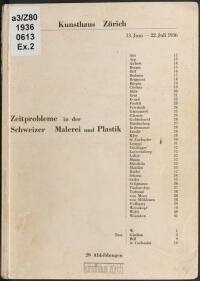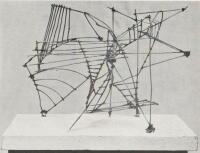Zeitprobleme in der Schweizer Malerei und Plastik
13.06.1936 – 22.07.1936
Curated by Wilhelm Wartmann.
Location Moser-Bau.
Curated by Wilhelm Wartmann.
Location Moser-Bau.
This exhibition, originally planned as 'New Problems in Swiss Painting and Sculpture', directed attention to the avantgarde in Switzerland and claimed to distill characteristics of the typical and new from it.
This exhibition was a ground-breaking one of its type. Its makers strove to do nothing less than to demonstrate that the 'new' in art, as already proclaimed in the 'International Exhibition of Contemporary Art' at the Kunsthaus Zurich in 1925 and put forward all over Europe as the most important feature of the 1920s in all areas of life, was not an invention confined to the sophisticated metropolis of Paris. The exhibition, originally planned as 'New Problems in Swiss Painting and Sculpture', directed people’s attention to the avantgarde in Switzerland, and according to Wilhelm Wartmann, the Kunsthaus Director of the time, the bridge to the art center of Paris had been struck, in particular, by Hans Arp, Max Bill, Le Corbusier and Leo Leuppi. The connection with other currents of the avantgarde in the 1920s, especially in Germany with New Objectivity, the Bauhaus, Expressionism and Surrealism, was not at the center here. Most remarkable on a formal level was the programmatic establishment of abstract and constructivist art, which was potentially explosive in times of growing political threats from authoritarian regimes in neighboring countries. At the same time, from today’s point of view, it is noticeable that artists defamed as 'decadent', such as Max Ernst, Ernst Ludwig Kirchner and Oskar Kokoschka, were not on show because as figurative artists they represented past currents of art rather than 'new' ones. Programmatically, this is also demonstrated in the catalog texts by Sigfried Giedion, Max Bill and Le Corbusier, all of whom, in their own ways, described the inherently constructive, autonomous character of art. This was most obvious in the contribution of Max Bill, where we read: 'Concrete design is the kind of design that arises from its own means and laws without having to borrow them or derive them from external natural appearances. The optical design is consequently based on color, form, space, light and movement.' As was customary at the time, this was also a sales exhibition, where the highest price quoted among all 159 exhibits was 4,000 Swiss francs for a Paul Klee.
[Cathérine Hug]
'Perhaps, especially through insights into what is now emerging, this exhibition will ensure that some visitors will let the pictures affect them according to no other criteria than the eyes of their own times. Only in that way can their meaning acquire life!'Sigfried Giedion, exh. cat.
39 days
39 Artists
39 Artists

1/3
exhibition catalog

2/3
exhibition view
Der grosse Saal, 1936
Der grosse Saal, 1936

3/3
exhibition view
1/3
